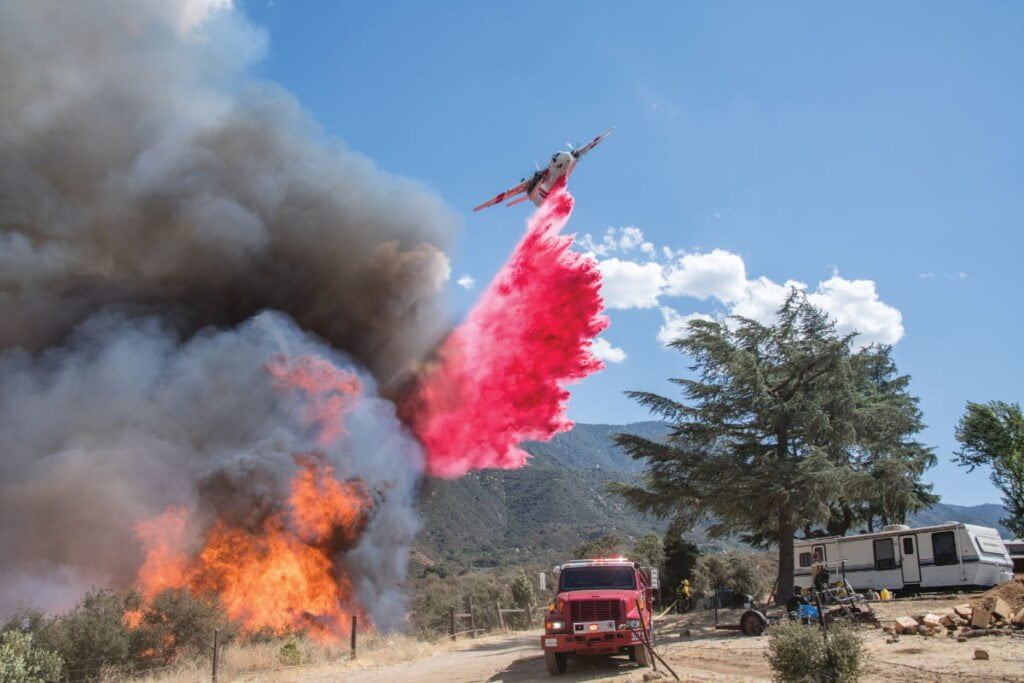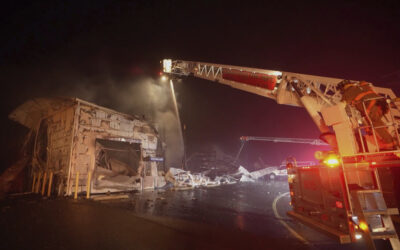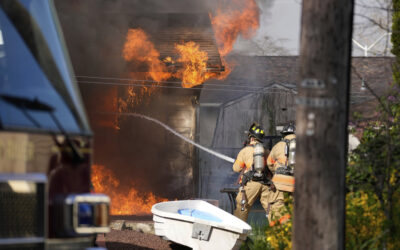By Melissa Kim
Fire safety leaves no room for error, and it doesn’t offer second chances. That is why it is critical that firefighters are equipped with the best tools when they battle any type of fire, including wildfires. Long-term fire retardant has been dropped from planes for more than 70 years to help contain and extinguish wildfires. The technology was rudimentary at first, but since that time, retardant has continually evolved in order to become more effective and environmentally responsible. Various active ingredients have been tested over the years, but today phosphate-based fire retardants are used by the U.S. Forest Service (USFS) and other fire management agencies around the world to help contain wildfires. How did we get to this point, and why is phosphate the active ingredient of choice for long-term fire retardants?
Putting Fire Retardant Chemicals to the Test
Retardant chemistry has been studied for decades. In fact, in 1954 the USFS launched a study to determine the effectiveness of various fire-retardant chemistries. Among the chemicals tested in the project were monoammonium phosphate, sodium silicate, ammonium chloride, magnesium chloride, and boric acid. The project was called Operation Firestop, and it was the first major study of its kind. Conducted at Camp Pendleton Marine Corps Base Camp, the testing was conducted to determine the effectiveness of new fire attack methods.
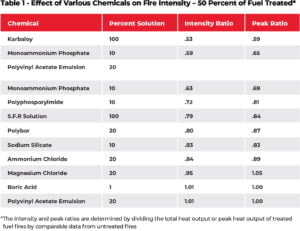 One phase of Operation Firestop tested the effect of fire-retardant chemicals on the ignition time of wood, on the fire intensity of burning wood, and the retardant’s ability to suppress flaming wood. The study included several chemicals that had been in use over the previous decades in firefighting products. The findings from Operation Firestop were clear, and they shaped the future of the retardant industry to this day. Ammonium phosphate was among the most effective chemicals in reducing fire intensity, while boric acid, magnesium chloride, and polyvinyl acetate were among the worst. (See Table 1 for study results.) Following this groundbreaking study, phosphate-based retardants became the industry standard, while boric acid, magnesium chloride, and polyvinyl acetate were discarded and no longer considered viable options as active ingredients for long-term retardants.
One phase of Operation Firestop tested the effect of fire-retardant chemicals on the ignition time of wood, on the fire intensity of burning wood, and the retardant’s ability to suppress flaming wood. The study included several chemicals that had been in use over the previous decades in firefighting products. The findings from Operation Firestop were clear, and they shaped the future of the retardant industry to this day. Ammonium phosphate was among the most effective chemicals in reducing fire intensity, while boric acid, magnesium chloride, and polyvinyl acetate were among the worst. (See Table 1 for study results.) Following this groundbreaking study, phosphate-based retardants became the industry standard, while boric acid, magnesium chloride, and polyvinyl acetate were discarded and no longer considered viable options as active ingredients for long-term retardants.
*The intensity and peak ratios are determined by dividing the total heat output or peak heat output of treated fuel fires by comparable data from untreated fires
Following Operation Firestop, Aylmer D. Blakely, a scientist from the University of Montana, conducted additional research on fire retardant chemicals in 1970. His findings were captured in his paper, A Laboratory Method for Evaluating Forest Fire Retardant Chemicals. Building on the results from Operation Firestop, Blakely included additional chemicals and identified more effectiveness parameters.
Blakely used what he called the “superiority factor method,” a composite of various factors combined to determine the overall effectiveness of different chemicals. These parameters included:
- The rate of weight loss
- The remaining residue after burning
- Amount of heat radiation emitted
Using the Blakely superiority factor, it was determined that any long-term fire retardant that measured greater than 0.3 on the scale was most effective; those that rated between 0.2 and 0.3 were moderately effective; and chemicals that scored between 0.1 and 0.2 were slightly effective. Blakely concluded (again) that ammonium phosphates topped the list of effective retardant chemicals (diammonium phosphates finished at the top, monoammonium phosphates ranked second). Potassium chloride was the least effective (finishing 14 out of 14 chemicals tested) and magnesium chloride finished ninth, failing to register any score above 0.3 in the tested superiority factors.
Retardant Technology Continues to Evolve
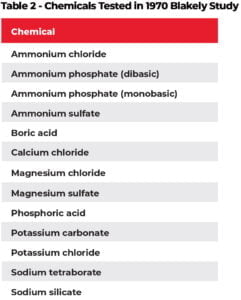 While these two studies from 1954 and 1970 both identified ammonium-phosphate as the most effective chemical fire retardant available at the time, phosphate-based fire retardants continued to evolve over the ensuing years as new innovations were introduced.
While these two studies from 1954 and 1970 both identified ammonium-phosphate as the most effective chemical fire retardant available at the time, phosphate-based fire retardants continued to evolve over the ensuing years as new innovations were introduced.
In 1971, Perimeter Solutions developed PHOS-CHEK 259-R. This was the first retardant that was colored with iron oxide. The red coloring made it easier for pilots to see where they were dropping fire retardant in order to create unbroken fire lines. PHOS-CHEK 259 also improved on the retardant’s corrosive properties. It is still on the market today, and it is the only retardant that meets the corrosion requirements for critical magnesium components in helicopters with fixed tanks.
In 1975, the first fugitive-colored PHOS-CHEK fire retardant was introduced. This was a critical innovation that provided fire management agencies the ability to effectively fight fires in aesthetically sensitive areas – such as national parks and wildland-urban interface areas – where iron oxide-colored retardants were less desirable or unacceptable. Today, PHOS-CHEK remains the only “true-fugitive“ fire retardant, where the red color disappears in a matter of weeks.
PHOS-CHEK commercially introduced retardants based on a synergistic blend of ammonium sulfate and
ammonium phosphates in 1985. The new blend provided fire retardant performance similar to ammonium phosphate retardants, but at a lower cost. In 1995, this phosphate/sulfate retardant blend was later eliminated in favor of a full phosphate formulation that provided more favorable environmental effects.
Perimeter Solutions’ PHOS-CHEK LC95 long-term fire retardant became the global standard in fire retardant in 2005, and then in November 2020, Perimeter Solutions introduced PHOS-CHEK LCE20-Fx. The newest retardant was built off the advanced PHOS-CHEK LC95, but it is more environmentally responsible and is more effective in targeting ground vegetation. PHOS-CHEK LCE20-Fx is expected to be the standard for fire retardants for the next 20 years.
As stated earlier, it is critical that firefighters are equipped with the best tools available. Fire management agencies have used phosphate-based retardants to successfully battle wildfires for years, while independent testing has proven that its more effective than other solutions, including magnesium chloride. That is why phosphate is the active ingredient of choice for effective long-term fire retardant.
Melissa Kim is Director of Research and Development at Perimeter Solutions
